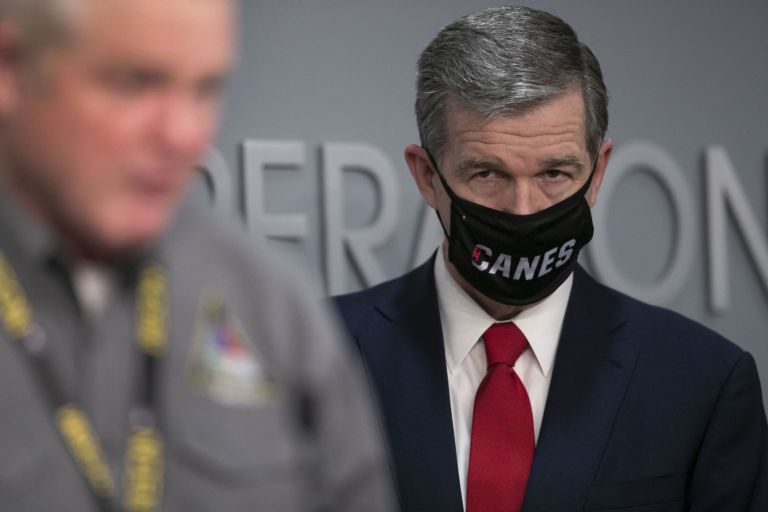Sign outside the Maywood, a downtown Raleigh bar and live music venue killed by Gov. Roy Cooper’s arbitrary and capricious orders issued beyond the bounds of the state Emergency Management Act.
Harvard Professor of Medicine Martin Kulldorff writes in spiked of the strange response he and other health experts received from U.S. media and big tech when they spoke from their expertise about the initial and ongoing response to the Covid-19 pandemic as they witnessed “basic principles of public health [were] thrown out of the window.” For example:
Unlike the 1918 Spanish Flu pandemic, children had much less to fear from Covid than from annual influenza or traffic accidents. They could get on with life unharmed — or so I thought.
For society at large, the conclusion was obvious. We had to protect older, high-risk people while younger low-risk adults kept society moving.
But that didn’t happen. Instead, schools closed while nursing homes went unprotected. Why? It made no sense.
I’m reminded that Gov. Roy Cooper still requires face masks on schoolchildren, with no scientific backing and only his gormless justification that Wull, they aren’t getting vaccinated yet. With the notable exception of A.P. Dillon, who did the unthinkable and asked the governor why he was keeping the “state of emergency” declaration, a question he inartfully dodged — media seemed mollified by state health functionary Mandy Cooper’s resort to the CDC guidelines rather than asking her or Cooper why they turned CDC recommendations into emergency orders in North Carolina.
Here’s another quote from Kulldorff:
Instead of understanding the pandemic, we were encouraged to fear it. Instead of life, we got lockdowns and death. We got delayed cancer diagnoses, worse cardiovascular-disease outcomes, deteriorating mental health, and a lot more collateral public-health damage from lockdown. Children, the elderly and the working class were the hardest hit by what can only be described as the biggest public-health fiasco in history.
I have written on the deadly unintended consequences from lockdowns in North Carolina, but to my dismay, North Carolina’s data reporting lags the rest of the nation by three months. In a three-part investigative series concluding in early March, I found the following without counting Covid deaths:
- NC has seen at least above-average deaths since the very first week of Gov. Roy Cooper’s shutdown
- NC suffered excess death events in April, May, and steadily since July
- These excess deaths looked to be getting worse by the week ending Sept. 19 (the last week for which NC’s all-cause death data seemed complete)
- Worse, NC was witnessing more excess deaths than COVID deaths
I spoke of my worry that lives are in the balance as Cohen’s department dithered and Cooper kept issuing tighter orders, without any way of seeing in real time if those orders are resulting in the very terrible, non-Covid health effects that research was increasingly warning about.
Kulldorff notes:
Something was clearly amiss with the media. Among infectious-disease epidemiology colleagues that I know, most favour focused protection of high-risk groups instead of lockdowns, but the media made it sound like there was a scientific consensus for general lockdowns
This problem has been screamingly obvious in North Carolina.
The Great Barrington Declaration and after
What happened next? Kulldorff writes:
In September, I met Jeffrey Tucker at the American Institute for Economic Research (AIER), an organisation I had never heard of before the pandemic. To help the media gain a better understanding of the pandemic, we decided to invite journalists to meet with infectious-disease epidemiologists in Great Barrington, New England, to conduct more in-depth interviews. I invited two scientists to join me, Sunetra Gupta from the University of Oxford, one of the world’s pre-eminent infectious-disease epidemiologists, and Jay Bhattacharya from Stanford University, an expert on infectious diseases and vulnerable populations. To the surprise of AIER, the three of us also decided to write a declaration arguing for focused protection instead of lockdowns. We called it the Great Barrington Declaration (GBD).
Opposition to lockdowns had been deemed unscientific. When scientists spoke out against lockdowns, they were ignored, considered a fringe voice, or accused of not having proper credentials. We thought it would be hard to ignore something authored by three senior infectious-disease epidemiologists from what were three respectable universities. We were right. All hell broke loose. That was good.
The GBD could not be ignored. But it transgressed the chosen way. So they were personally vilified to scare away others from speaking out. Kulldorf:
When writing the declaration, we knew we were exposing ourselves to attacks. That can be scary, but as Rosa Parks said: ‘I have learned over the years that when one’s mind is made up, this diminishes fear; knowing what must be done does away with fear.’
As events proved them right, they — the health experts who stood by the basic principles of public health against the entire political class, including the likes of Cooper and Cohen, not to mention the Babbitts and nabobs of the notion that all science suddenly changed in April 2020 — were silenced, censored, and harassed:
Had we been wrong, our scientific colleagues might have taken pity on us and the media would have gone back to ignoring us. Being correct means that we embarrassed some immensely powerful people in politics, journalism, big tech and science. They are never going to forgive us.
Please, read the entire piece.


